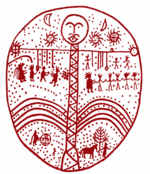Similar topics
"What is Ayahuasca?" -
Page 1 of 1
 "What is Ayahuasca?" -
"What is Ayahuasca?" -
See the Ayahuasca Foundation for more:
The word "Ayahuasca" refers to a medicinal and magical drink with the main ingredient being the ayahuasca vine (banisteriopsis caapi). The vine is cooked, usually in combination with a variety of other admixture plants, to eventually produce a brown liquid that is consumed in healing ceremonies led by Amazon healers, called ayahuasqueros, (curanderos). The effects of the brew vary greatly depending on which admixture plants are used in its preparation.
The plants most often used are the leaves of chacruna (Psychotria viridis) and yagé; also known as chalipanga, chagraponga, and huambisa (Diplopterys cabrerana). Ayahuasca is known and used throughout Perú, Ecuador, Colombia, Bolivia, and western Brazil. The use of ayahuasca is rapidly gaining awareness and acceptance in South America and elsewhere thanks to organized religious movements such as Santo Daime and the União do Vegetal (UDV), who recently won a supreme court decision for the right of members to use the sacred medicine in ceremonies in the United States.
It has been used in the Peruvian Amazon for millenia, long before the Spanish came to Peru, before the Incan Empire was formed, before history. The oldest known object related to the use of ayahuasca is a ceremonial cup which dates to a culture that ended in the year 50 A.D. Hewn out of stone with engraved ornamentation, it was discovered in Ecuador and currently rests at the Ethnological Museum of the Central University (Quito, Ecuador). In the Peruvian Amazon, its use dates back much further.
The Ayahuasca medicine usually contains both beta-carboline and tryptamine alkaloids. However, some indigenous Amazonian cultures, like the Yahua, prepare their ceremonial brew using only the ayahuasca vine. The ayahuasca vine contains the beta-carbolines (harmine, harmaline, and tetrahydroharmine). Harmine and harmaline are visionary at high levels, but at a modest dosage typically produce mainly tranquility and purgation. Tetrahydroharmine is present in significant levels in ayahuasca. It may be responsible for some of its more profound effects.
The ratio of these harmala alkaloids in the ayahuasca vine varies greatly from one geographical area to another in the Amazon basin. Even though all are botanically classified as Banisteriopsis caapi. The curanderos classify them further, in reference to their effects. An example is cielo ayahuasca, which means sky or heaven ayahuasca, implying that its effect is of bringing one to celestial realms. Negra ayahuasca, or black ayahuasca, would be used to work specifically with black magic, and so on...
Harmala alkaloids have an the unique effect of temporarily reducing levels of monoamine oxidase in the body. Monoamine oxidase is an enzyme that normally breaks down tryptamine alkaloids, among others. Monoamine oxidase inhibitors (MAOIs) thus make tryptamines orally active. Therefore, the ayahuasca plays an essential role in the brew, opening the door for a host of powerful alkoloids to reach the brain before eventually being broken down by other means.
The principal tryptamine found in ayahuasca is DiMethyl Tryptamine, or DMT. This naturally-occurring biochemical substance is secreted by the human brain in the pineal gland. It occurs in countless plant species throuhout the world, and is the subject of many new and interesting research projects. It can produce very powerful visionary effects when smoked in its pure form or taken orally in Ayahuasca or with another MAOI.
While some scientists might describe the Ayahuasca experience as merely an oral DMT experience activated by a beta carboline MAO inhibitor. This description is not accurate, for the healing processes at work within the medicine are far more complex, unquestionably due to the ayahuasca vine which is responsible for the transformative power of the Ayahuasca experience. One could easily point to the name of the medicine to know that it is the vine that gives the brew its power, and this idea is supported by nearly every culture that uses ayahuasca in the Amazon Rainforest.
Here is a quote from Richard Evans Shultes, one of the earliest pioneers in ayahuasca research, describing merely the effects of the vine alone:"To this day, the natives of the north-west Amazon in Brazil and Colombia use the Banisteriopsis drink for prophetic and divinatory purposes and also to fortify the bravery of male adolescents about to undergo the severely painful yurupari ceremony for initiation into manhood. The narcosis amongst these peoples, with whom I have taken caapi on many occasions, is usually pleasant, characterized by visual hallucinations in colour, which initially is very often a shade of blue or purple. In excessive doses, it is said to bring on frighteningly nightmarish visions and a feeling of extremely reckless abandon, although consciousness is not lost nor is use of the limbs unduly affected".

ankh_f_n_khonsu- Number of posts : 545
Registration date : 2008-09-15
 Similar topics
Similar topics» "How *NOT* to drink ayahuasca" -
» "The Grand-daddy of all Fake Terror Fall Guys: Guy Fawkes" -
» "The Equinox & Solstice Ceremonies of the Golden Dawn", by Pat & Chris Zalewski
» "The Grand-daddy of all Fake Terror Fall Guys: Guy Fawkes" -
» "The Equinox & Solstice Ceremonies of the Golden Dawn", by Pat & Chris Zalewski
Page 1 of 1
Permissions in this forum:
You cannot reply to topics in this forum
